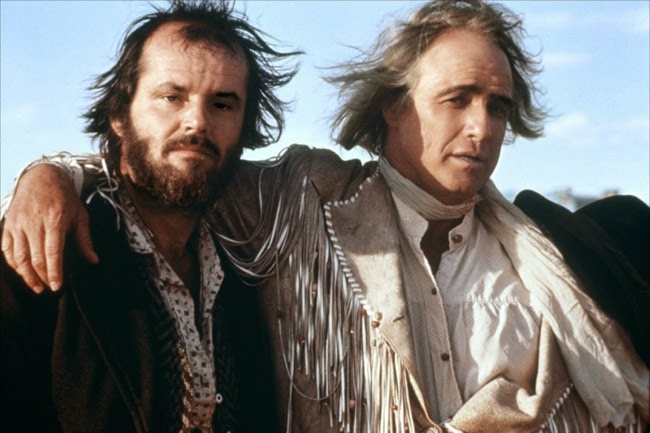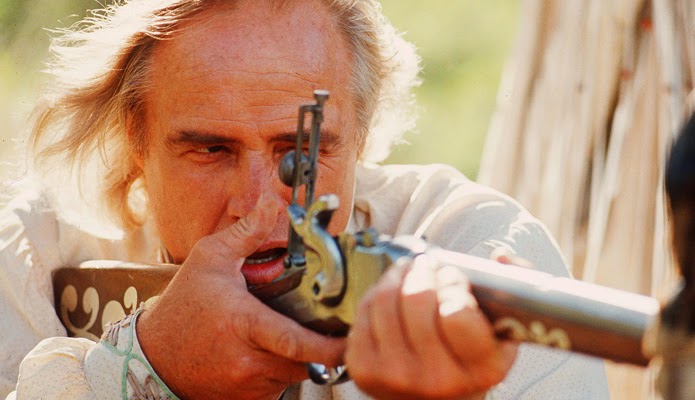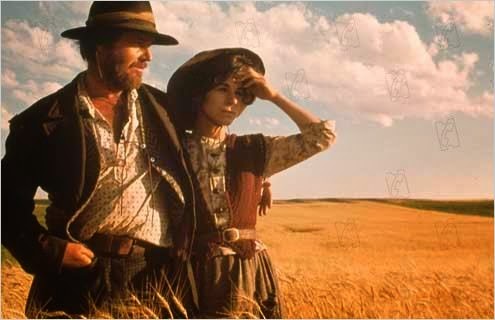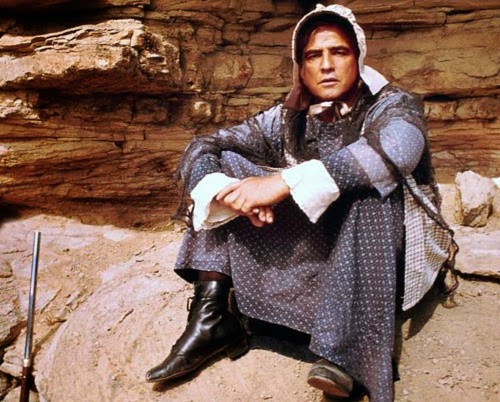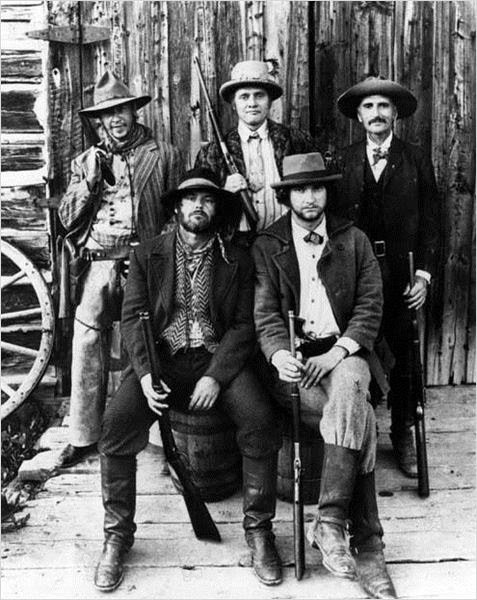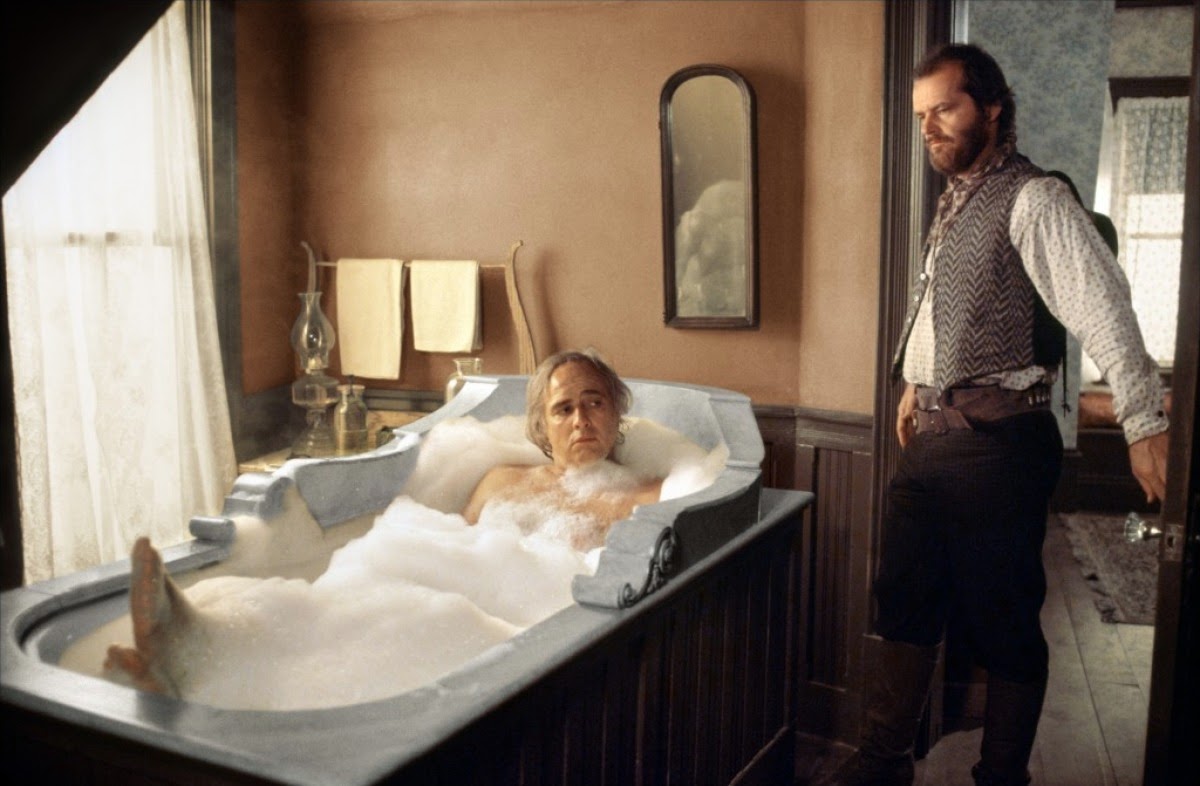THE MISSOURI BREAKS
(US - 1976)
Directed by Arthur Penn. Written by Thomas McGuane. Cast: Marlon Brando, Jack Nicholson, Randy Quaid, Kathleen Lloyd, Frederic Forrest, Harry Dean Stanton, John McLiam, John P. Ryan, Sam Gilman, Steve Franken, Richard Bradford, Luana Anders, Hunter von Leer, Virgil Frye, Dan Ades. (PG, 126 mins)
When it was released in theaters in the summer of 1976, the western THE MISSOURI BREAKS was arguably the anticipated event film of the season. It was the first and ultimately only pairing of Marlon Brando, offscreen since his GODFATHER/LAST TANGO IN PARIS triumphs of 1972 and 1973, and Jack Nicholson, who had just won the Best Actor Oscar for the previous year's ONE FLEW OVER THE CUCKOO'S NEST. The script was written by acclaimed novelist and screenwriter Thomas McGuane (92 IN THE SHADE, RANCHO DELUXE) right in the midst of a particularly chaotic, excess-fueled phase of his life where those close to him were dubbing him "Captain Berserko." Like seemingly every major 1970s studio film, it also featured additional script contributions by an uncredited Robert Towne (THE LAST DETAIL, CHINATOWN). The director was Arthur Penn, no stranger to westerns (1958's THE LEFT HANDED GUN, 1970's LITTLE BIG MAN), but best known for his iconic BONNIE AND CLYDE (1967). In short, THE MISSOURI BREAKS' pedigree was without doubt. This was the very definition of a sure thing.
Then, much to the detriment of everyone involved, it was released. Critics hated it. Audiences hated it. The word-of-mouth was toxic. The movie bombed.
There's no shortage of notable, worthwhile, and even classic films that tanked on their initial release only to find appreciation some time--weeks, months, years, decades--later. THE MISSOURI BREAKS existed in that odd time between the auteurist, maverick mindset that became the Hollywood norm post-EASY RIDER, and the new summer blockbuster ethos ushered in the previous year by JAWS and made industry standard the next summer with STAR WARS. While most of 1976's biggest moneymakers (ROCKY, A STAR IS BORN, KING KONG, SILVER STREAK) were released in the fall, the two most successful films of the summer represented both ends of the spectrum: the topical ALL THE PRESIDENT'S MEN was released in April and continued to be a huge hit throughout the summer, and THE OMEN was released in June. THE MISSOURI BREAKS was flat-out rejected by everyone. There's a good chance that if it came out a few years earlier, it might've gotten a more hospitable reception. If it came out a few years later, it would've been focus-grouped into losing its personality and engineered into a commercial crowd-pleaser. On one hand, it's a film that refuses to stick to convention, but on the other, a western that promised a face-off between what many considered film's greatest living actor and his heir apparent and instead turned their confrontation into an anticlimactic afterthought that practically takes place offscreen does feel like a bit of a dick move.
THE MISSOURI BREAKS opens with wealthy northern Montana ranch owner Braxton (John McLiam) and his strongarm Pete (Richard Bradford) overseeing the execution-by-hanging of Sandy (Hunter von Leer), who was caught trying to rustle horses off of Braxton's property. Sandy was part of a group of horse thieves led by Tom Logan (Nicholson). Logan and the rest of the gang--Calvin (Harry Dean Stanton), Little Tod (Randy Quaid), Cary (Frederic Forrest), and Si (John P. Ryan)--hatch a plan that involves using money from a nearly-botched train robbery to buy a ranch near Braxton's land. While the other four men are off on a separate horse-rustling job near the Canadian border, Logan is planting crops and creating the illusion of being an upstanding citizen while plotting his revenge on Braxton, even being cordial with Braxton and secretly courting his fiercely independent daughter Jane (Kathleen Lloyd). After Logan secretly kills Pete and leaves him hanging from the same tree where Sandy was executed, Braxton hires legendary "regulator" Robert E. Lee Clayton (Brando), an eccentric, lilac-perfurmed Irish bounty hunter, to track down and bring to justice (meaning, kill) the men responsible. Clayton sees right through Logan's "average farmer" act, which sets the stage for the regulator obsessively pursuing the other men and offing them one by one before coming back for Logan, who goes soft when he grows accustomed to working an honest living and finding true love with Jane. "You're pretty far gone, ain't ya?" Calvin asks in disgust as Logan beams with pride over the progress of his ranch work. "That's how it happens, isn't it?" Logan shrugs. The deranged Clayton manages to take over Braxton's ranch, usurping his power and instilling his own brand of HIGH PLAINS DRIFTER terror to the townsfolk, getting under Braxton's skin enough that the rancher can't call him off the job and Clayton, who's now just in it for the kill, doesn't even want to be paid. "It's about the job," he says with wild eyes. "I always finish the job."
The revisionist nature of THE MISSOURI BREAKS makes it easy to see what drew Penn to the project. With BONNIE AND CLYDE and LITTLE BIG MAN and even his 1975 box-office flop NIGHT MOVES, a film dismissed in its day and now regarded as one of the essential films of its decade, he was a filmmaker who thrived on the offbeat, the unexpected, and the groundbreaking. For a while in the early-going, THE MISSOURI BREAKS is very similar to the quieter moments in some of Sam Peckinpah's westerns--it's beautifully-photographed (by Michael Butler), with very deliberate pacing and a focus on character development, like Logan initially vowing revenge but finding he might just want to live a quiet farming life. Nicholson turns in a surprisingly restrained, understated performance, rarely raising his voice and only very sporadically resorting to some quintessential "Jack" late in the game when Clayton forces his hand by killing all of his friends. His performance is more in line with the work he had recently done for Michelangelo Antonioni in 1975's THE PASSENGER rather than the McMurphy schtick of CUCKOO'S NEST. He seems happy to be part of the ensemble of great character actors that make up his gang, and he's very charismatic in his scenes with Lloyd, a charming actress who should've been bigger and is largely forgotten today (she went on to co-star in THE CAR, reunite with Forrest and Ryan and Larry Cohen's IT LIVES AGAIN, and have a recurring role on MAGNUM, P.I. before spending the next three decades doing TV guest spots). Penn's handling of the Nicholson end of the plot is indicative of a filmmaker in control of his vision. Where THE MISSOURI BREAKS loses its balance--and not necessarily in a bad way--is with Brando.
This was Brando's first film appearance in three years, and it's essentially the beginning of the final phase of his career: the "I'm just going to riff and do what I want because I'm Marlon Brando and I'm getting paid more than everybody else here" phase. This is the Brando who showed up on the APOCALYPSE NOW set without having read the script and opting to intentionally stall filming because his contract stipulated that he stood to make more money if he was still needed after a certain date. This is the Brando who wore an ice bucket on his head for no reason in THE ISLAND OF DR. MOREAU. This is the Brando who was now almost openly contemptuous of his craft and the whole concept of Hollywood. Brando had a history of being difficult and, at least with 1969's THE NIGHT OF THE FOLLOWING DAY, purposefully attempting to sabotage a film with his antics, but while he may be undisciplined, unfocused, and impossibly hammy in THE MISSOURI BREAKS, he's doing what he needs to do keep things interesting, and from the looks of it, he's having a blast. Penn directed Brando in 1966's underrated THE CHASE, which contains one of the actor's best performances from his mid-to-late 1960s downward spiral. Only a decade had passed, but it wasn't the same controlled, serious Brando who showed up to work on THE MISSOURI BREAKS. Brando first appears around the 35-minute mark, hanging off a horse and sporting an over-the-top Irish brogue that sounds like a tribute to his MUTINY ON THE BOUNTY co-star Richard Harris. His performance is a parade of eccentricities that starts off quirky and rapidly escalates to gonzo. He walks into Pete's funeral, roughs up the body, lying in ice in a casket, and proceeds to grab some ice cubes and rub them all over his face. Elsewhere, Brando's Clayton dons a variety of costumes in his pursuit of Logan's gang, disguising himself as a mandolin-strumming preacher mumbling through mouthful of tobacco and later, maniacally cackling in drag in a frontier granny dress as he hurls a spike through someone's head. He sets another on fire while screaming "Smoked meat!" He plays with bubbles in the bathtub. He taunts Braxton while wearing a dorky derby and munching on a plate of raw carrots like a distinguished Bugs Bunny. When Braxton tells Clayton "You're out of control!" it's hard to tell if McLiam is in character or talking to Brando personally. Brando treats the entire project as a self-indulgent, absurdist playground, opting to goof off to his heart's content on United Artists' dime (interestingly, the studio would go bankrupt in four years with another revisionist western, Michael Cimino's much more costly and similarly-reviled-and-now-reconsidered HEAVEN'S GATE), but unlike some of his later films (CHRISTOPHER COLUMBUS: THE DISCOVERY, anyone?), no one can accuse him of phoning this one in. 1976 audiences might've been pissed off, but Brando was having the time of his life.
Brando grows more unhinged with each passing scene, and while his material is at odds with the relative seriousness of the rest of the film (there's bits of dark humor here and there, like a blubbering Ryan crying "It ain't even legal!" when some Canadian Mounties have the audacity to cross the border to take back their stolen horses), they give THE MISSOURI BREAKS much of its unique personality. Over the years, it's Brando's insane performance that's drawn people to the film, not the horse-rustling plot or the romance between Nicholson and Lloyd. THE MISSOURI BREAKS has a level of weirdness that's probably very off-putting for a first-time viewer or those 1976 audiences who expected a more traditional western. Audiences who loathed THE MISSOURI BREAKS responded much more positively to Clint Eastwood's THE OUTLAW JOSEY WALES, released a month later, but westerns were generally moving away from the John Wayne tradition (though the Duke went out strong in 1976 with THE SHOOTIST), with offbeat films like THE MISSOURI BREAKS, Robert Altman's BUFFALO BILL AND THE INDIANS OR SITTING BULL'S HISTORY LESSON, and Andrew V. McLaglen's THE LAST HARD MEN. In THE MISSOURI BREAKS, Brando and Nicholson have a few scenes together, but they spend the bulk of the film apart, and the only really lunkheaded artistic decision Penn and McGuane make is in the final confrontation between Clayton and Logan, which is virtually over before it even begins. It's not quite the resolution that the teaming of titans like Brando and Nicholson would seemingly promise.
Though it has yet to enjoy a NIGHT MOVES-style renaissance, THE MISSOURI BREAKS' reputation has improved significantly over the years, at least as far as fans of bizarre cult movies are concerned. In addition to critics hating it, the film also got some bad press after it was condemned by the American Humane Association when one horse drowned and several others were injured at various points in the shoot. It was also revealed that the crew was using tripwires on the horses, a practice that the AHA and the major studios previously agreed to cease, and the responsibility for that rightfully fell on Penn and the producers. It's a slow, strange film, almost revisionist to the point of being an anti-western, and it's hard to argue with anyone who finds it a bit of a misfire (it still rates a "BOMB" in Leonard Maltin's movie guide, which calls it "a great director's worst film and one of the worst 'big' movies ever made"). It's a film frequently at odds with itself, almost like Penn realized that trying to corral Brando was a lost cause so he instead focused on what he could control. Perhaps Nicholson's restraint was a sympathetic concession to his director, like the actor realized the film (and Penn, for the matter) didn't need two outrageous, mischievous scamps trying to out-ham one another. After THE MISSOURI BREAKS, Penn never again tackled a huge, highly-publicized project of this sort. He laid low, spending five years licking his wounds and waiting for the smoke to clear before returning with 1981's character-driven drama FOUR FRIENDS, a film filled with a cast of relative newcomers like Craig Wasson, who wouldn't give him any headaches or force him to measure up to impossible expectations. He made a few more films, the most notable being 1987's underrated suspense thriller DEAD OF WINTER, before retiring after directing an episode of the Sidney Lumet-produced TV series 100 CENTRE STREET in 2001. Penn died in 2010 at the age of 88, hopefully aware that THE MISSOURI BREAKS, while a flawed mess, is a much more worthwhile, intriguing, and entertaining film than the moviegoers of 1976 realized.

